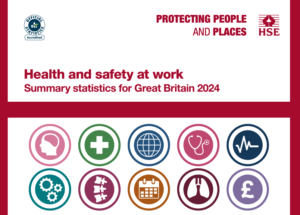The report presents several key areas of risk, many of which are like those reported in 22/23 as having the highest rate of injury and fatality. See below our summary of key points:
Mental Health impacts the work force considerably: 776,000 worker suffering from work – related stress, depression, and anxiety! Employer expectations, long working hours, program demands, personal expectations, volumes of work, colleague support and many other workplace contributing factors significantly impact our workers mental health. Clearly these figures should focus employers on the need to implement considerate and robust measures to support their workers mental health and wellbeing.
Falls from height are still the most common cause of work-related fatalities: 50 fatal injuries were due to falls from height in 2023/24, accounting for 36% of all worker deaths over the year (138). An increase on the previous year’s figure, suggesting that risks concerning working from height are still not being effectively managed. Where possible, the need to work from height should be eliminated at the planning stage. Specific regulations, including and the Work at Height Regulations and guidance documents such as INDG401 should be referred to aide employers on reducing and mitigating risk where work from height cannot be avoided.
Construction still accounts for the highest number of fatalities: The construction industry faces numerous challenges that increase risk from long working hours in the summer and shorter working hours in the winter, ever changing program deadlines and physically challenging environments and practices. This year’s statistics, show that the industry once again accounted for the highest number of work-related fatalities in 2023/24. Increasing from 47 in 2022/23 to 51 in 2023/24, the number of fatalities in construction suggests that the industry has much to do to improve worker safety.
Older members of the workforce are most at risk of fatal injury: Despite making up only 11% of the workforce, workers aged 60 and over accounted for 34% of all worker fatalities in 2023/24. Considering that the number of people aged 65 and over in full-time employment has increased steadily over the past two decades, these figures should direct an employer’s focus on their expectations and risk mitigation measures for this cohort of workers. Specific risk assessments may not always be required for older workers, it is important for employers to consider the activities required and involve older workers in assessing risk and making reasonable adjustments where needed. It is also important to be aware of workers who have done the same or similar tasks for a prolonged period of time, as over-familiarity with work can lead to safety being overlooked.
Risks must also be managed for self-employed workers and contractors: The number of work-related fatalities to self-employed workers varies by industry, the report shows that this cohort accounted for 36% of fatal injuries in 2023/24. Industries such as construction, agriculture, forestry, and fishing presented the highest rate of fatal injury to self-employed workers. Whether a worker is an employee, or a self -employed contractor, businesses have a legal responsibility to manage their health and safety. This involves ensuring that every worker understands the safety procedures and is adequately trained, whether they are on the books or not.
Protecting the public: The numbers of members of the public killed because of work-related activities has raised alarmingly, from 73 in 2022/23, to 87 in 2023/24. Under Section 3 of the Health & Safety at Work etc Act 1974, employers have a duty to “ensure, so far as is reasonably practicable, that persons not in his employment who may be affected thereby are not thereby exposed to risks to their health or safety”. Employers have a responsibility to ensure the safety of any person(s) who may come into contact with their work activities, whether that is by ensuring robust traffic and pedestrian management systems are place, or by installing appropriate security measures to prevent unauthorised access.











